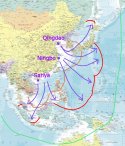They are much slower than helos they carry and their rocket-launched torpedoesNuclear attack submarines are still faster than surface ships. What I think will happen more is persistent undersea sonar networks. And then the attack submarines can act as interceptors, you launch them to intercept a target and use active sonar to engage.
Actually no. Subs can't use active sonar unless they are really desperate. It gives away their presence and location. In the cold war, passive sonar on the sub was the king. Below layer and very long range. But passive sonar absolutely sucks against modern submarines that are quieter than the background noise. And active sonar has improved a lot and towed variable-depth active arrays became common. Now, ships detect submarines from longer distances compared to other subs.The ships use active sonar, just like submarines, and are slower than nuclear attack submarines. So I really do not see how this is true. It is true that aircraft are a problem. But they use two means to detect submarines, sonobuys, or magnetic anomaly detectors. And they strike submarines with either mines or torpedos. I think you will see submarines use composite materials on the hull or non-magnetic materials which render the magnetic anomaly detectors useless.
You also forgot radars and infrared detectors. Which are the bane of submarines that have to snorkel (aka SSKs).
More like 15 km at best if you want your torpedo to evade detection long enough and still catch up to the ship. Down to 5-10 km against ships at flank speed. Remember, torpedos are slow munitions and their targets' speed is significant. 45 nm range at 45 knots only equals 15 knots effective range against a vessel at 30 knots."Short" ranged is like 50-60km...
It complicates ranging too because of multiple reflections. Ranging takes a lot of time without using the periscope which makes you helo food. SSKs have it even worse.It might be possible to process the signal if your sonar is stationary you can likely just filter out the background.
China is using active sonar anyway. Soryus are scary quiet according to everyone that went against it. Well below background noise.Soryu is not particularly quiet. The Swedish Stirling engines they use are mechanical engines and quite noisy. Fuel cells like on German submarines should be a lot quieter.
Machinery is still steelLike I said you can use a composite hull or some other non-magnetic hull and try to reduce the visibility of the SSK.
In tests Germans were able to detect an ASW helicopter by sonar using its downwash on the sea surface. Look at the IDAS missile. You can cue it by the sub's radar too. It is an act of desperation by the sub but it counts. So helos can't just recklessly use dipping sonar everywhere they are suspicious of.And just where will you put the sensor on the submarine? Radar would make the submarine visible, and IR sensors would likely work poorly from under water.
It prevents you from getting stalked by space and aviation assets for a few weeks. Quite important.Not really. At least not current AIP. Which in all cases is really low power.
I don't agree. China needs to be able to go on a submarine offensive beyond the first island chain. Chinese SSNs will be persistent threats. Have really good 30 SSNs and deploy 20 of them to the West Pacific before starting to conquer Taiwan. US planners will have to think a lot more times. Also, there is a chain effect. CVNs further away and less mobile -> more Chinese MPAs and ASW ships -> Less aggressive US SSNs -> A lot more PLAN warships -> even more area denial. SSKs can't do this effectively, it is not WW2 anymore.Maybe. Until China pushes out beyond the first island chain the nuclear submarines won't be all that useful to be honest.

